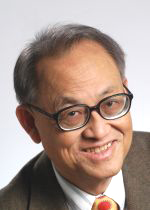Go to
June 15, 2017
Memristors and the Principle of Local Activity
Friday, 15 June 2017 at 16:00 in room SV 1717
Leon Chua, University of California, Berkeley
Abstract:
The first part of this talk presents the axiomatic basis of the ideal memristor and its generalized experimental definition via its pinched hysteresis loops. A fundamental new theorem will be presented which asserts that all non-volatile memories that did not require a power supply, or quantum-mechanical-effects, must exhibit a continuum range of memories, which can be tuned to emulate synapses.
In particular, we will show that the modulation of neurotransmitters during learning is akin to tuning the conductance of a memristor. We will emulate the classic Kandel Aplysia learning experiments, as well as Bliss-Lomo's long term potentiation (LTP) phenomenon with a single memristor. Moreover, we will solve the heretofore unresolved Hodgkin-Huxley Paradox on the shocking gigantic inductance they had measured from the squid axon by showing the potassium and sodium ion channels which Hodgkin and Huxley had erroneously identified as time-varying conductances are in fact time-invariant memristors.
Furthermore, we will present an experimental voltage-divider circuit containing only one Ag/AgInSbTe/Ta memristive synapse capable of mimicking Pavlov's conditioning experiments on dogs, thereby demonstrating the associative learning phenomenon.
The second part of this talk presents a new law of thermodynamics, dubbed the Principle of Local Activity, which allows the entropy to decrease, and provides the rigorous mathematical foundation for the generation of action potentials in the Hodgkin-Huxley equation, as well as Alan Turing's seminal paper on the emergence of complex phenomena and morphogenesis.
We conclude this talk by showing that intelligence and life must operate in a Goldilock's zone of local activity, dubbed the edge of chaos.
About the speaker:
 Leon Chua received his MSEE degree from MIT in 1961. He received his PhD degree from the University of Illinois, Urbana-Champaign in 1964, with a thesis titled ‘Nonlinear Network Analysis – The Parametric Approach’. He became an Assistant Professor of Electrical Engineering at Purdue University in 1964, and was promoted to Associate Professor in 1967. In 1971, he joined the faculty of the University of California, Berkeley, where he has remained ever since.
Leon Chua received his MSEE degree from MIT in 1961. He received his PhD degree from the University of Illinois, Urbana-Champaign in 1964, with a thesis titled ‘Nonlinear Network Analysis – The Parametric Approach’. He became an Assistant Professor of Electrical Engineering at Purdue University in 1964, and was promoted to Associate Professor in 1967. In 1971, he joined the faculty of the University of California, Berkeley, where he has remained ever since.
Dr. Leon O. Chua is widely recognized as the father of nonlinear circuit theory and cellular neural networks (CNN). The CNN architecture is the only one implemented into a practical fully-programmable chip for solving ultra-high-speed pattern recognition and image processing problems. The CNN universal machine chip is capable of a thousand times greater performance in speed, weight and power consumption than related technologies. Dr. Chua also invented a five-element circuit for generating chaotic signals. Aptly named the Chua Circuit, it is used by many researchers to design secure communications systems based on chaos. Dr. Chua was the first to conceive the theories behind, and postulate the existence of, the memristor. Thirty-seven years after he predicted its existence, a working solid-state memristor was created by a team at Hewlett Packard.
An IEEE Fellow, he is a past president of the IEEE Circuits and Systems Society and former editor of the IEEE Transactions on Circuits and Systems. He is the Editor of The International Journal of Bifurcation and Chaos.
Dr. Chua has nine honorary doctorate degrees from prestigious universities across the world, like the AGH University of Science and Technology (Poland), University of Frankfurt (Germany), University of Tokushima (Japan), to name a few. In 2002 he was named among the top fifteen most cited engineering authors. He has won numerous awards, like the IEEE Centennial Medal in 1985, the IEEE Circuits and Systems Society Golden Jubilee Medal in 2000, the IEEE Third Millenium Medal and the IEEE Neutral Networks Pioneer Award, also in 2000 and the IEEE Gustav Robert Kirchhoff Award in 2005.
Secondary navigation
- January 29, 2018
- August 30, 2017
- Past seminars
- 2016 - 2017 Seminars
- 2015 - 2016 Seminars
- 2014 - 2015 Seminars
- 2013 - 2014 Seminars
- 2012 - 2013 Seminars
- 2011 - 2012 Seminars
- 2010 - 2011 Seminars
- 2009 - 2010 Seminars
- 2008 - 2009 Seminars
- 2007 - 2008 Seminars
- 2006 - 2007 Seminars
- August 31, 2007
- June 29, 2007
- June 20, 2007
- June 5, 2007
- May 30, 2007
- May 16, 2007
- May 15, 2007
- April 24, 2007
- March 27, 2007
- March 14, 2007
- February 9, 2007
- February 8, 2007
- January 12, 2007
- December 5, 2006
- November 14, 2006
- October 31, 2006
- October 27, 2006
- October 26, 2006
- October 20, 2006
- September 20, 2006
- September 20, 2006
- September 20, 2006
- September 19, 2006
- 2005 - 2006 Seminars
- August 23, 2006
- August 22, 2006
- June 26, 2006
- June 20, 2006
- June 16, 2006
- June 7, 2006
- June 6, 2006
- May 30, 2006
- May 17, 2006
- May 10, 2006
- April 27, 2006
- April 12, 2006
- March 31, 2006
- March 29, 2006
- March 22, 2006
- March 15, 2006
- February 27, 2006
- February 8, 2006
- January 25, 2006
- January 19, 2006
- January 18, 2006
- January 17, 2006
- January 11, 2006
- November 30, 2005
- November 23, 2005
- November 2, 2005
- October 26, 2005
- October 25, 2005
- October 5, 2005
- September 28, 2005
- 2005 Seminars

